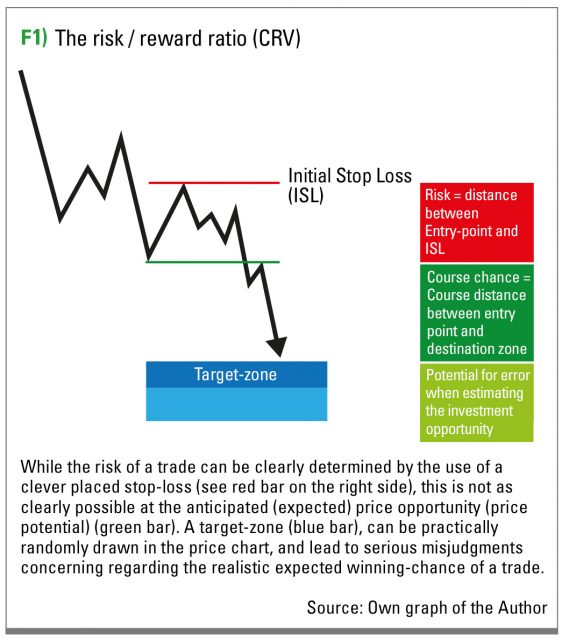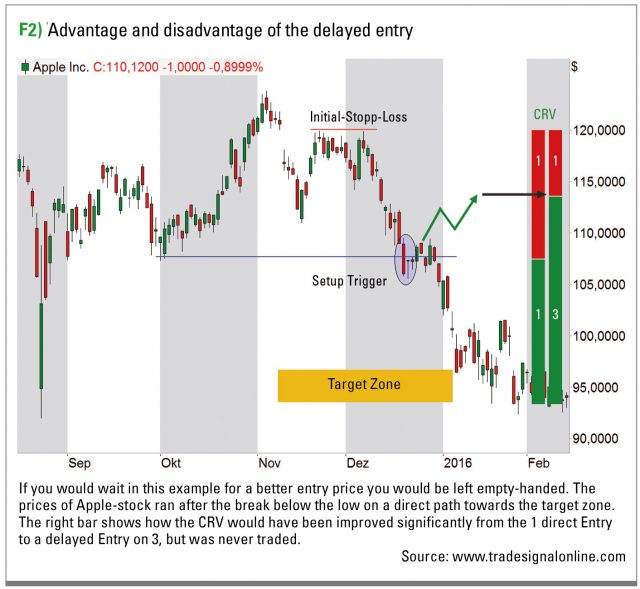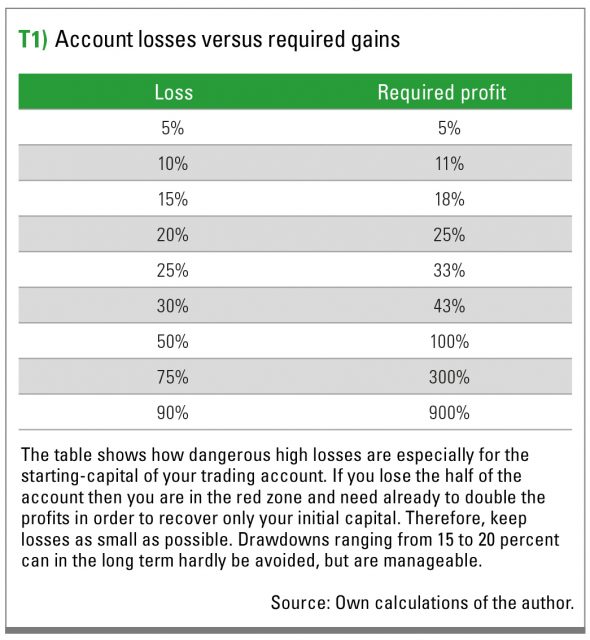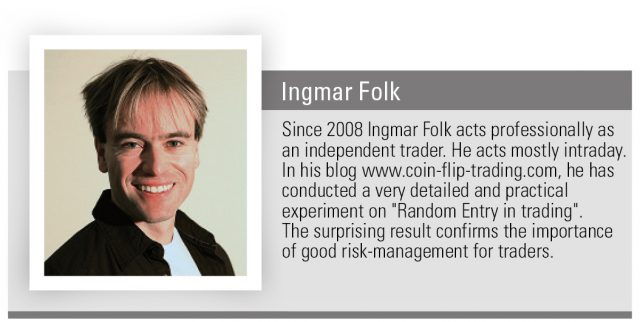Profit-factor. Risk Management

How to benefit from the correct Entries and Exits
When it comes to “risk management’’ in trading, most people think of the term “stop-loss”. The somewhat advanced Exchange-friends use the word “position size”. Both true. For a comprehensive understanding of the concept of risk in trading on the financial markets, also Exit and Entry must be considered. These are usually associated with the Trade Management. However, that’s only half the story. Both the Exit and the Entry must be considered as a separate risk-adjustment-screw. That is what the following article is about.
The position size as the main screw
Experienced traders know that the position size of trades (number of contracts traded / shares et cetera) is the most powerful risk screw, which they can turn when trading on the financial markets. There are many strategies or algorithms that can help you as a trader to trade a suitable for you position-size. One of the most useful approaches is to adjust the position size per trade relative to account size. The smaller your trading account is, the lower should be your number of traded securities. Each position is – as far as possible – provided with an approximately equal absolute risk. This is particularly useful, because you may not know if your next trade will be profitable or not. The rule of thumb here is that the bigger the stop loss, the lower the position size of a trade and vice versa. But beware: Who over tightens this risk-screw and enters too much risk per trade based on his trading-capital will be exposed to massive fluctuations in his account. You will have to find a healthy compromise between individual risk tolerance and your own personal trading goals. Here’s an example: Suppose your trading account is EUR 20 000. You want to buy the Bund futures at 156.50 points, where your market-technically Initial-Stopp-Loss is placed at 156.30 points. Your risk per contract purchased is thus 20 ticks or 200 Euro (1 tick = 1/100 point = 10 Euro). Your trading plan gives you 400 Euro as maximum risk for a single trade. In order calculate the optimal position-size, you have to divide the 400 euros by the risk per contract – so 200 euros. Accordingly, you can trade two contracts on this trade. Once your account has grown to EUR 30 000, you want to risk a maximum of 600 Euros per trade. In this case, then divide the 600 euros – with an otherwise identical scenario – by 200 euros and could buy three contracts. If your initial stop-loss was only ten ticks large, divide 600 Euro by Euro 100 risk per contract. Now your optimal position size would be as much as six contracts. You should pay attention that the risk in a single trade is not more than two percent of your trading capital.
Risk / reward ratio
As a trader, you also need to keep in mind the opportunity-risk ratio, usually expressed as a ratio. In its calculation, the maximum risk of a trade is assessed in relation to the potential profit. The first ratio stands for the chance to win (your defined target) the second for the maximum risk (your defined stop). While the risk of a trade through the use of clever placed stop-loss – as shown in Figure 1 – can be clearly identified (see red bar on the right side), this is not as clearly possible at the expected course-chance (price potential). A target-zone, can be drawn practically arbitrarily in the chart. This can lead inexperienced traders to serious misjudgments regarding the realistic expected winning-chance of a trade. Therefore calculate always conservative when calculating your CRV.

The exit strategy
The exit from a trading position – the second risk screw – is associated by most people only with the Trade Management. Basically, that’s not wrong. The only question is what is actually managed here? You will think, of course the Trade. That is also correct. But actually you can manage with the exit of a Trade actively your financial risk that has been given originally to a particular Trade. What exactly is meant? To illustrate this, the author brings the following statement into play: In fact there are no book gains in Trading. Since you, any time with a single click or shortcut on your keyboard, can directly resolve and settle the current position at the current price is the so-called book profit – just like the book loss – in truth a fallacy. This will entice you as a trader to consider (look, think) Trades better than they are and to ignore the truth in your P/L (Profit/Loss; gain and loss) statement. So look the truth rather directly in the face and accept the current market price as what it is: the basis for calculating your actual account balance in the trading account. This point of view will make you automatically see the Exit respectively an Exit-Strategy as an important tool for managing the risk of your trades. For many, the Exit does not mean much more than a half-hearted predefined Pi-times-thumb-tactic to end a Trade. Is your Trade 20 points in the win and you have not changed your initial stop-loss of ten points, you know in the future that you are already 30 points in the risk and not about ten points (the size of the initial stops) as the book-profit-accounting makes you believe. This stricter definition of risk is extremely important when it comes to retighten the stop loss. Suppose you have, by the above mentioned Trade, a profit target of 30 points. If you keep your initial stop at a book-profit of 20 points, you will risk at this point 30 points and play (gamble) for another ten points extra profit. The more the movement progresses the less likely it is that there are further profits. It is better that you calculate without book-profits and reasonably the Stop-Loss. a clever exit consists mostly from the interaction of mathematics, personal risk tolerance and market-technically meaningfully placed Stop-Loss. This example shows that the risk of a trade is controlled through the Exit as through the position size or the initial-Stop-Loss – after all it represents only an Exit-Variant. Also partial Exits are used for risk-management of trades. Through these advanced Exit-Tactics you can control your personal financial risk, which you are able or want to give (grant) a Trade. The basic principle here: never to risk too much for too little.

The Entry-tactics
The third ‘screw’ for the risk is the Entry in the market. Where is the connection-point between the Entry and the Risk of a trade? Depending on how aggressive a trader enters the market, the actually used Size of his Stop-Loss changes through the Entry. The following applies: The more aggressive the Entry, the faster for example during a breakout-signal a position is opened, the greater your initial stop must be. How can that be? Normally, a trader when placing the Initial-Stop-Loss is primarily based on important market-technical price-areas (relative highs/lows, support/resistance zones, daily High/Low et cetera). If you do not want to place randomly your Stop-Loss in the so-called market-noise, you have to risk the more points, the more confident your participation in a market-movement is. An aggressive Market-Entry means nothing more than a chronologically very early opening of a position. You do not wait for greater reaction of the course to enter, but accept a lower price for the opening of the position. If you, however, are willing to wait for better prices (price-pullback according to Setup-Trigger) and enter later, your financial risk in this trade will be decreased – the necessary initial-stop-loss becomes smaller. But there is good reasons not always hope for the best starting price: The longer you delay the opening of a position, in order to save money, the higher the probability to miss completely this trading opportunity. The subsequent costs can be immense, because a clear missed opportunity can be regarded as losing trade. And it can be exactly equivalent to the theoretical profit that would have been resulted from this opportunity. Since you, as a good trader, are interested in letting your profits run, you should be aware that here often accumulations of multiple amounts of the planned initial-risk of a trade can occur. The chart in Figure 2 shows the risk of attempted delayed Entry (green arrow). If you wait for better entry prices, you often miss completely the trading opportunity. That’s why an aggressive Entry (directly at the break below the low – blue line) costs more money and the CRV gets often worse because the distance to the stop-loss is larger, but also because at the same time the price potential is lower. In some situations, a more aggressive Entry can lead to a reduction of the Stop-Loss. This is the case, for example, if you want to anticipate a breakout setup. You have then to take a position before an anticipated breakout above/below important price-levels. In this way, the distance between the Entry-point and the Stop-Loss is decreased and thus your maximum risk for this trade is also decreased. The anticipation of a clearly defined setup-trigger should be the exception and not the rule in your trading. This applies even more for less experienced traders.

Conclusion
Speculating or betting on price-changes on the financial markets – nothing else than trading – follows the basic rules of professional betting game. The term “trading” leads to other conclusions, which is why beginners rarely perceive themselves as a risk manager. A comprehensive professional risk management includes – for you as a trader- the selection a reputable broker, but also suitable equipment. This is especially true if you are day trader. Here, technical breakdowns can lead to high extraordinary costs because as day trader you’re trading highly leveraged and you have less reaction-time available. Finally, you are even, in the person as a trader, a risk factor. Nothing is more dangerous in the long run for your trading account than yourself, if you are prone to indiscipline. Keep that in mind. Work out a decent trading plan that meets all the technical risk-screws and train constantly your discipline, trading automation and mental abilities. Thereby you will be able to counter all eventualities emerging in trading with the best possible for you decisions.


